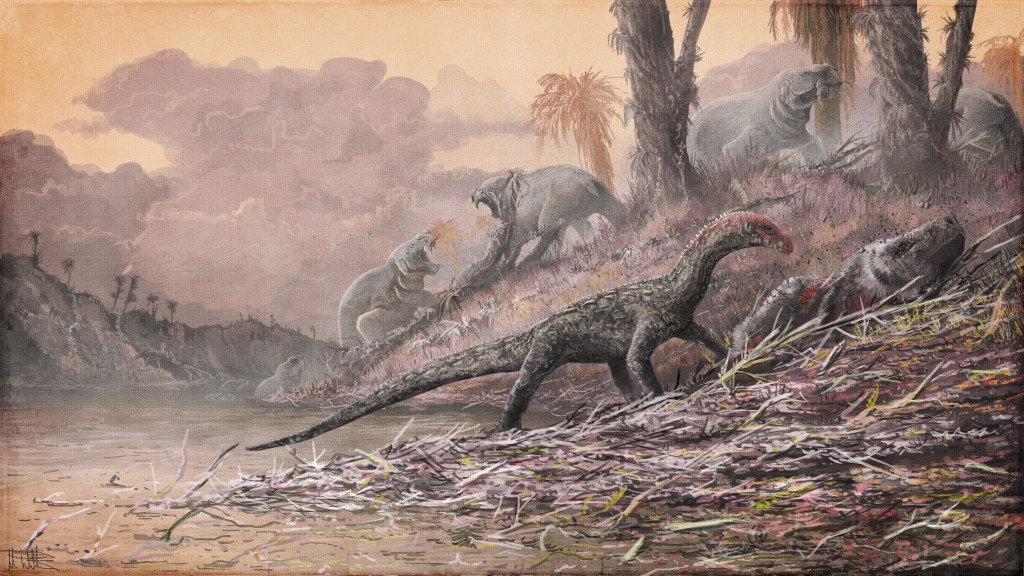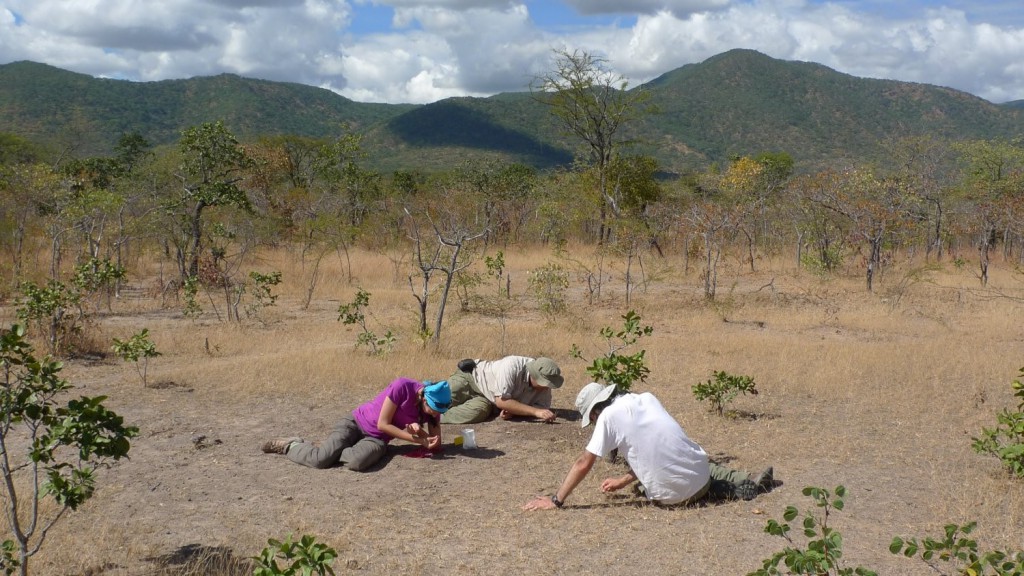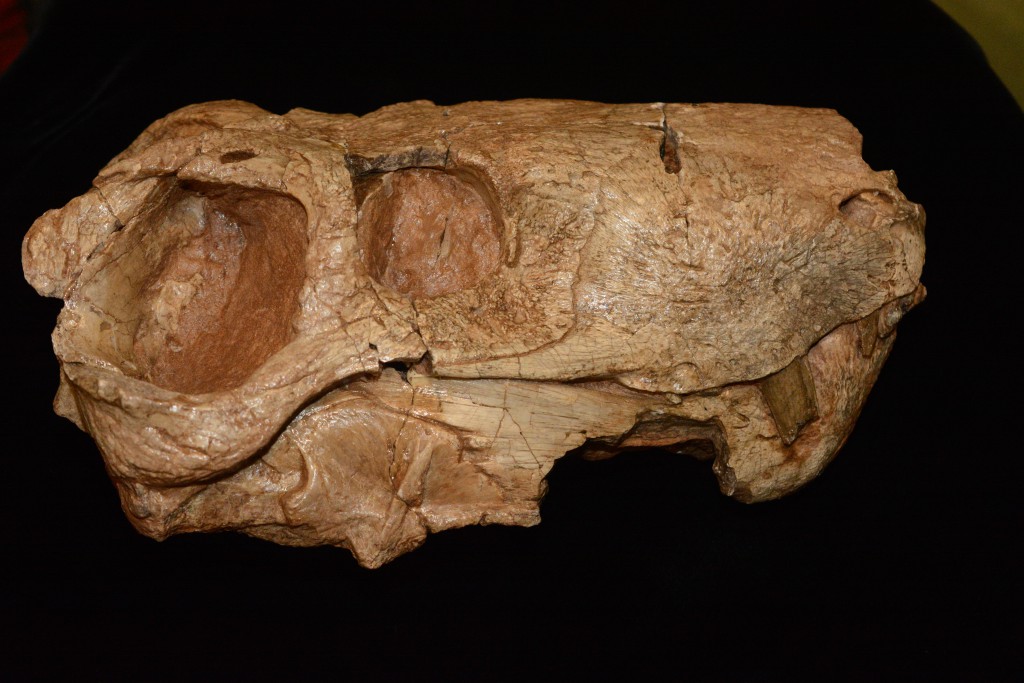Triassic Park: A Decade-Long Labor To Recreate A Lost World
Posted on Categories Discover Magazine

Welcome to Triassic Park! Researchers spent a decade working at remote African sites to fill in serious gaps in our understanding of life at the Dawn of the Dinosaur Age. The scene, including dino-relative Teleocrater in foreground, illustrates what mid-Triassic Tanzania might have looked like 240 million years ago. (Credit Mark Witton/Natural History Museum, London)
You’ve probably heard about The Great Dying, more formally known as the End-Permian mass extinction, when more than 95 percent of species worldwide went extinct. This darkest hour in the story of life on Earth occurred some 251 million years ago, most likely the result of monstrous, region-wide volcanic activity in Siberia that acidified the oceans, wrecked the climate and may have even ripped open the ozone layer to allow in rather nasty levels of ultraviolet radiation.
But…what happened next?
Life got knocked down, but it got up again. (Apologies if you now have an earworm stuck in your head. Actually, no. I’m not sorry at all.)
Surviving species recovered and even thrived. In time, biodiversity exploded. New ecological hierarchies formed and expanded. While there were obvious losers at the end of the Permian Period, there were also clear winners emerging in the Triassic that followed — including two upstart lineages that would eventually make quite a name for themselves: dinosaurs and mammals.
Unfortunately, much of what we know about the Triassic and the Great Recovery, as it might be called, comes from a small number of locations. In the Southern Hemisphere, the Karoo Basin of South Africa has been the primary site for telling the story spanning the Permian and Triassic. Although fossil finds from the Karoo have been numerous and significant, they reveal only a narrow geographic slice of what was happening during this critical period of loss and recovery.
Thanks to a decade-long project, however, researchers are finally able to lay the foundations for a new understanding, a regional picture of what life was like in the Triassic in the Southern Hemisphere beyond the Karoo. Published today by the Society of Vertebrate Paleontology as part of their memoir series, the team, led by University of Washington paleontologist Christian Sidor, offers 13 different studies — adding to the 24 papers already published during the project — that help to recreate the Triassic World in better detail than ever before.

Project members digging up a whole new world in Tanzania in 2015 as part of a decade-long effort to understand the period following the End-Permian mass extinction 251 million years ago. (Credit Christian Sidor/University of Washington)
Although the memoir is not available online (not even the abstracts…sorry, friends, I asked!), a summary of the information provided in the publication’s introduction gives a sense of the scope of their efforts. Some of the highlights:
- More than 2,000 new fossils from sites in Tanzania and Zambia. Fossils collected from both countries in the early and mid-20th century were often dug up and dispatched, with poor context preservation, to museums scattered around the world. Details such as the exact place in the layers of rock the fossil was found, a crucial piece of evidence for understanding a specimen’s significance, were lost. That means that, while paleontologists knew that southern Tanzania’s Ruhuhu Basin and Zambia’s Luangwa Basin were Triassic treasure troves, most of the material from there was problematic to place into a larger picture. The new fossils collected during the project described today, however, arrive on the academic stage with oodles of data points about their geographic and stratigraphic locations. Context is everything.
- New modeling methods designed for the project have already helped the researchers understand how life in the Ruhuhu and Luangwa was similar to — and different from — the Karoo, the first time paleontologists have been able to sketch regional v. local ecologies for the Triassic in the Southern Hemisphere. The methods, the team hopes, can be used elsewhere in the fossil record to make similar comparisons.
- Loads of paleoenvironmental information, much of it gleaned from analyzing layers of sediment never before studied. The material helps researchers create snapshots of the climate in these areas during different points in the Triassic, which began some 250 million years ago and lasted for about 50 million years. It’s one thing to have a bunch of well-documented fossils, but it’s quite another to have detailed climate reconstructions on hand which can help paleontologists understand how different kinds of animals adapted — or went extinct — in the face of climate shifts. Determining a new way of measuring ancient Triassic rainfall is another method developed during the project that researchers believe will be useful for other teams recreating paleoenvironments across geologic time.
- A fuller analysis of Teleocrater, the early dinosaur relative first described in 2017 which raised a number of questions about when dinosaurs split from the rest of the archosaurs. The remains of several other animals, some exceptionally well-preserved and some new to science, also enjoy the spotlight in the publication.
So What?
Maybe you started reading this post thinking I was going to detail a ton of new species, or give you an exact description of what, say, climate was like in the Triassic. Nope. I was able to get my hands only on the introduction to the baker’s dozen papers published today, and again, none of them have open-access links.
The truth is, even though many of the details in today’s publication are not readily accessible to everyone, the mere existence of the project, and its success, is what should be celebrated.
Since the earliest days of paleontology in the 19th century, much of the focus, and the hypotheses formed, centered around the Northern Hemisphere. Europe and North America (and more recently China) drew the most intense interest. Fossils collected from other corners of the world, particularly Africa, often were dismissed (see, for example, a recent second look at some fossils from the Karoo).
In the 21st century, however, paleontology is branching out both in the geographic regions explored and the people exploring them. That’s why we’re learning about pterosaurs from Morocco, and why young women in Egypt are uncovering new species while helping to build rigorous, locally-based paleontology programs.
The researchers behind today’s pile of studies plan to continue their work in Tanzania and Zambia, and more teams than ever before are working in Africa in general, as well as South America. Personally, I think that’s terrific. Rigorous expanded research can only lead to new understanding, and that’s a good thing. It’s how paleontology, like any other field of science, advances.

Before the Triassic period, before dinosaurs, before even the Great Dying that was the End-Permian mass extinction, gorgonopsids ruled the day, at least on land. Then the Permian ended and so did they. They couldn’t adapt to the new world around them. Don’t be a gorgonopsid. (Gorgonopsid skull collected by members of the Tanzania-Zambia Project in Zambia in 2009.) (Credit Christian Sidor/University of Washington)